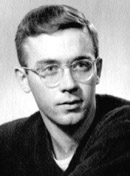

MY HP REFLECTIONS
Charles (Bud) Eldon, April 2012
Was Community and Industrial Volunteering Valued at HP?
Community service was a well-known corporate value at Hewlett-Packard (see Corporate Objective # 7, as presented by Dave himself). Bill and Dave, as well as Porter and Oliver, then later John Young and Don Hammond, held well-remembered positions on the Palo Alto Council and School Board, Stanford's Board of Trustees and fund-raising programs, and IEEE. Dozens of employees over the decades reached outside of their HP jobs to take on industrial volunteer and community service roles. For this they earned some recognition among their peers, ALWAYS they received personal satisfaction and often, service awards from their chosen organizations.
And yet, for the size of HP and the thousands of employees, the number of these volunteers were distinctly in the minority. Worse, it was my observation that their HP middle management bosses often didn't show the same recognition of corporate value for their efforts, as perhaps Objective 7 would proclaim. Buds speaks highly of some of his managers who were strongly supportive of his IEEE work. While their service brought important customer recognition to Hewlett Packard as a sponsor, back home, it sometimes was a more mixed response as managers filled out the annual job performance reviews. There is no way to tell whether the later years of HP got better or worse in this indicator.
Bud Eldon is a clear case in point. His "assignments" by Ed Porter, per Bill Hewlett, to get out and volunteer resulted in a lifetime of IEEE achievements and personal satisfaction. He even got some kudos from Packard and Hewlett and Barney for some of his IEEE work, and later John Young and Lew Platt, when Bud got elected President of IEEE." (All of those "kudos" were offered: all of them were supportive.) Yet I believe that was not the norm at HP. This was a pity, because so much good was done by those armies of unsung volunteers.
Perhaps Bud's remembrances will help their satisfaction.
For Bud, his IEEE recognition came in the year 2000, when he was summoned to New York to receive the Haraden Pratt Service Award for his distinguished service, which recognized his committed service well beyond the year of his 1985 Presidency.
John Minck,
April, 2012
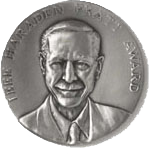 |
2000 - CHARLES A. ELDON
|
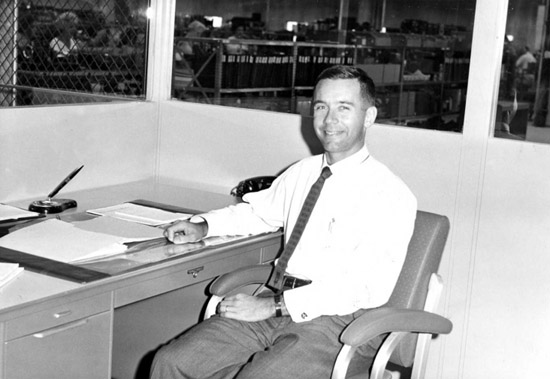 |
| Bud Eldon at HP New Jersey Division in 1961 Courtesy of the Hewlett Packard Company |
MY HP REFLECTIONS
Surely all of us who worked at HP during the 1950s, '60s, and '70s, and knew our legendary leaders of that time, have fond and grateful memories. But how many of us have reflected on what that job environment produced in our lives, especially considering what assignments we were given? For this remembrance, I'll consider here a few of the seemingly casual community service assignments I received and how they literally influenced my entire life.
One day in 1955, my boss, Ed Porter, walked down the aisle from the "head offices" to my desk, sat ON my desk (not by it), and said to me, "Bill and I would like you to set up in the Bay Area a chapter of IRE's Group on Product Engineering and Production." To which I remember clearly asking, "What's IRE"? Porter laughed and responded, "IRE is the Institute of Radio Engineers. As you should know, Bud, Bill is the president." "Oh, I replied. I'm not a member. My major was physics, not radio engineering." "Don't worry, Bud, we'll get you in as a member. OK? Will you do that?" "Sure, I'll try" I replied cautiously not having any idea what was involved.
Consequence? Hewlett's secretary gave me the telephone number of Emily Sirjane at IRE's headquarters in NY City. "So I called and was welcomed to apply. She sent the forms and procedures both to join and to set up a Bay Area Chapter of an IRE Technical Group, called PEP (for Product Engineering and Production). Then I called several of the companies on the Peninsula to make contact with manufacturing engineers and supervisors whom I invited to a meeting to discuss setting up that IRE technical group "for exchanging ideas and experiences." It turned out to be great fun getting acquainted and holding meetings. Soon we decided to organize an international conference that made a pile of money (and parties for us team leaders). Those opportunities to visit one another at work, with me learning clever design and manufacturing tricks, all became valuable to HP by me implementing them, in my job as a manufacturing engineer and production supervisor.
As that Group's organizer of a local Chapter, I was invited to become a member of PEP's international leadership committee. That's when HP transferred me to Boonton Radio Corp in New Jersey, to be the Manufacturing Manager. The next year I got elected Group Chairman of PEP, but soon I was transferred back to Palo Alto.
Almost immediately, due to my PEP position, I got another HP "casual" assignment from HP's VP of R&D, Barney Oliver, a newly-elected VP of IEEE. This was a crucial organizational period, consumed with implementing the merger of IRE with AIEE. Barney asserted that IRE had too many small technical groups; so he directed me, as Chairman of PEP, to see if I could merge it with some other IRE Group. Dutifully, I approached Lou Kahn, president of the Component Parts Group, and we agreed to merge it with PEP into what now is known as the CPMT Society of IEEE.
Because of that activity, I was asked by IEEE leaders in the San Francisco Section to be one of the candidates for the Section's Executive Committee. Obviously, by "representing" HP, I was elected. In 1973, I became Chairman of the Section. That was the year when the West Coast Electronics Association (WEMA) decided to get out of the "show" business and move to "management" activities, by selling its 50% ownership of WESCON. The other 50% had been owned equally by the SF and LA Councils of IEEE. Incidentally, Bill Hewlett, Noel Eldred (HP's Marketing VP, and others from HP had been involved in creating the original WEMA.
As chairman of the SF Council, which I had upgraded from Section classification to be like LA, I naturally was assigned to negotiate with WEMA to buy their 50% for IEEE. The agreed price was $54K. But a serious "political" complication developed. The Director of Region 6 (all Sections in the 11 Western states) wanted "IEEE" as a corporation, instead of the 2 West Coast Councils, to be the new owner, and thus to get the profits that would be produced by WESCON. The SF and LA Council members reacted vehemently, having been the sole IEEE owners, thus counting on future income for their respective local activities and expansions.
So I worked with an attorney in LA to set up a new, "not for profit" corporation. I called it EEEI: Electrical & Electronic Exhibitions, Inc (the name later would be changed to ECI: Electronic Conventions, Inc); it would own the WESCON show. I invited leaders of ERA (Electronic Representative Assn) to buy 30% of EEEI for about what IEEE had paid for WEMA's 50%. However, I had to get approval of the IEEE ExCom (leadership) for such a unique new organization. That was emotional, time-consuming and hard, but eventually it was approved. Having one-on-one arguments with a few past and present presidents and vice presidents of IEEE definitely made me believe that I'd never have any future assignments, or even contacts, within IEEE. I suspected that I'd be persona non grata. Worse yet, damage to the reputation of HP within IEEE seemed inevitable, also.
Imagine my surprise when I got a personal telephone call from Art Stern, then VP of RAB (the coordinating Board for all Sections and Councils); he was the probable next President-elect of IEEE. He asked if I'd be willing and able to be his RAB finance chairman. I was stunned, being certain that I'd insulted him in my negotiations with the IEEE ExCom about EEEI's foundation -- especially its independence from IEEE. But it would have been a greater insult, of course, to refuse his offer. So I accepted. That was fortuitous: it gave me experience and contacts with the "corporate" level of IEEE and automatically made me a member of the IEEE Budget Committee, working with Controller Tom Bartlett. That experience was invaluable.
Meanwhile, back at HP working for Noel Eldred, I'd gotten involved with fundraising for Stanford, another HP "community," first for the Graduate School of Business (GSB), then as a leader in the General Fund, always identified with HP. I became chairman of the mid-level Fund, chairman of an international leadership meeting, president of the GSB Fund, then VP of Stanford Associates, the overall Fundraising entity. After several nice recognitions I was awarded the Gold Spike in 1973, the highest fundraising award there is at Stanford. No other HP volunteer had received it; although John Young, Hewlett and Packard got elected to the Stanford Board of Trustees at one time or another.
A few years later I was asked if I'd be available and willing to be a candidate for Director of Region 6, thus a member of the IEEE Board of Directors. Learning that the other candidate was a local VP-Engineering, I agreed, certain that I was to be simply a pawn for his election. Evidently what happened is that, because I was identified as an engineer/manager at HP, the votes went to me. But it did get me back into Tom Bartlett's budget committee, as well as a volunteer representing HP. Management supported me again.
Yet at the end of my Region 6 term, in 1980, IEEE was having serious financial problems; so I volunteered to be a candidate for IEEE Treasurer, the only position that I ever sought, before or since. My Stanford MBA education and HP assignments made me believe that I could be helpful. HP management had approved and I got elected, then had fun helping Bartlett fix the funding problems and budgeting procedures. I suspect that my experience with HP budgeting and financial planning was also helpful.
After 2 years as Treasurer I was asked by Jerry Suran, a Past President and thus chairman of the Nominations Committee, to be a candidate for Executive VP, with responsibilities for direction of all IEEE shows and conferences. Again because of HP assignments, as well as WESCON and IEEE history, I was elected. I felt certain that would end my IEEE leadership assignments; so I told VP Hal Edmondson and others that I was coming to the end of my IEEE activity. And that I would welcome, in particular, a foreign manufacturing assignment for HP, such as in Singapore or Malaysia.
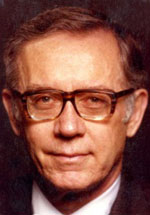 |
Bud Eldon, IEEE President, 1985 |
Fate intervened: the President-elect for 1985, a VP of Phillips, died unexpectedly, leaving it to the IEEE Board of Directors to select a replacement, rather than having a special election. As the recent EVP, I was an obvious candidate. But I had to get an OK from HP to be a candidate. Surprise: when I called Hal Edmondson to seek approval, contrary to my earlier assertion that I was finished with IEEE, he instantly replied, "That would be such a big honor for HP -- as well as you -- you've got to go for it. We'll take care of your duties in HP; don't worry about that." So I told the Board that I would be available from HP; I was elected President-elect for 1985.
I was overwhelmed as well as honored as well as scared: I'd never thought myself qualified for IEEE President -- even interested; I was totally un-prepared. Then came congratulations from John Young and Dave Packard himself and from Norm Neely, with questions and suggestions from Barney and Bill Hewlett: it was quite overwhelming. This was a big deal for HP, too! Here I was, following the footsteps of Bill Hewlett and Barney Oliver into leading the largest engineering organization in the world, with 230,000 members in 130 countries!
Because of this attention, in my opinion, a couple of ECI-related managers got information and "references" from folks at HP and told me they were nominating me for Fellow grade. "No, I said, I've never invented an instrument; so I'm not qualified." I killed the effort. But soon after that, 2 of the Directors got some of my technical work from HP, plus that as president of Ness Pacific and Pacific Assemblers. Those were the 2 "off-shoring" companies in Indonesia and Hong Kong I'd run (profitably) in 1970-72, while I'd been away from HP in the venture capital field. So they nominated me in spite of my protestations. They were unduly convincing, I guess: I was elected to Fellow Grade in 1987, after I was no longer on the Board, and thus eligible again.
So there I was, President, then Fellow, of IEEE, all a result of Porter and Hewlett asking me to help IRE with a project that should be good for HP, too. Being from HP did it all, in my view. But I also had been implementing Packard's Corporate Objective # 7, "CITIZENSHIP: To honor our obligations to.......each community in which we operate." And I had heard him say, when he introduced that objective at the January, 1957 "Sonoma" first-ever management meeting, "one community is IRE." The recognition to me definitely was due to HP efforts "to honor our obligations...!" Clearly, due to Packard's contributions to Stanford, that's another entity for which I was highly honored, explicitly because I was trying "to honor our HP obligations." Basically HP was honored, not me.
My "bottom line": As I said and wrote again and again, I demonstrated great skill (OK, luck!) at being "in the right place at the right time" to draw favorable attention to what I was asked to do outside of HP. The last time I asserted that view publicly was in June, 2000, at the IEEE Centennial Celebration, where I was awarded the IEEE Haraden Pratt Award, for "service"--- my proudest moment among all those described above. In fact all my efforts were aimed at "to honor our obligations to ... each community in which we operate": in IEEE and Stanford, for HP.
Surely other HP employees had similar rewarding experiences that resulted from similar "casual" assignments (or volunteer efforts) and that I'm not alone in expressing gratitude!
Bud Eldon
An illustration of Bud's activity at Hewlett Packard in 1963, Systems and Operations Analysis Manager
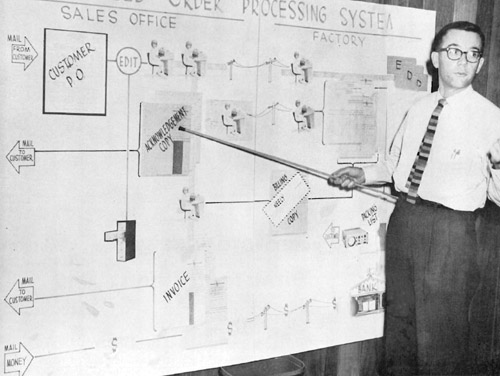 |
| Bud Eldon explains decentralized order processing system to executive council in Palo Alto. Chart traces an order from the time it is received until the money is deposited in the bank. From Measure Magazine, September 1963 - Courtesy of the Hewlett Packard Company |
Task force reports amazing results in field trial...
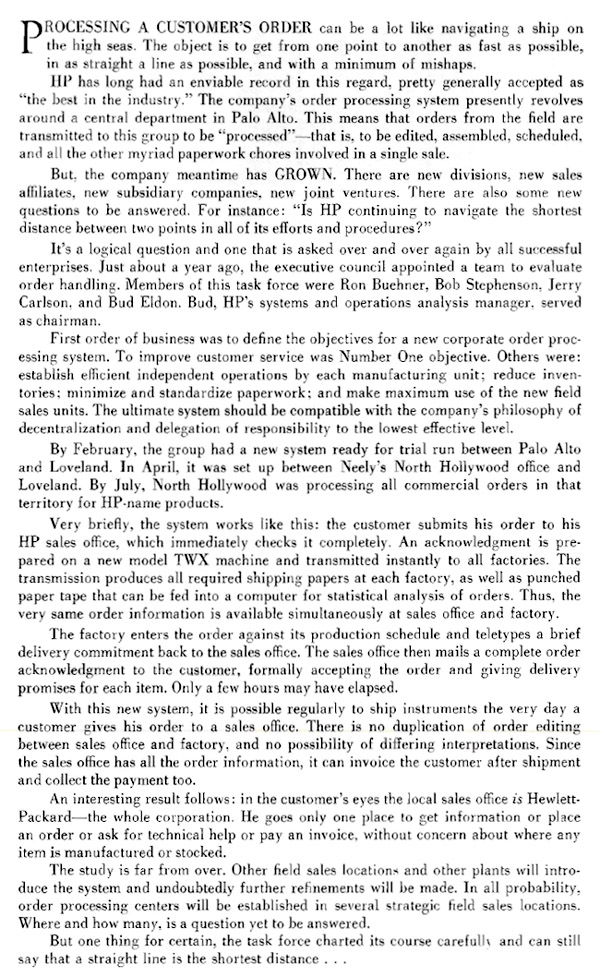 |
| From Measure Magazine, September 1963 - Courtesy of the Hewlett Packard Company |
